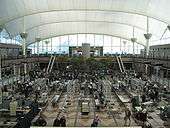Transportation in Colorado

Colorado's transportation network consists of a network of highway, surface street, rail, and air transportation options. While the public transportation system in Denver is much more complex and developed than other parts of the state, tourism and growth have led to extensive needs statewide.
Roads and highways
Overview
Colorado is a landlocked state, so ground and air transportation are the primary focus of the state. Also, due to low population density outside of the Denver and Colorado Springs metropolitan areas, highways are the primary transportation method for the majority of residents.
Interstate and U.S. Highways

The main north–south route in Colorado is Interstate 25 (I-25). The I-25 corridor follows the front range of the Colorado Rockies and connects Denver, Colorado Springs, Pueblo, Fort Collins, Greeley, Trinidad, and other small cities. I-70 crosses Colorado from west to east and is a primary viaduct for tourists and locals to visit mountain communities. When it was completed, the section of I-70 passing through Glenwood Canyon was the most expensive section of Interstate highway ever built in the United States with a total cost of $490 million for the 12-mile-long (19 km) stretch.[1]
Due to winter weather conditions, sections of I-70 are regularly closed during the winter and are expensive to maintain.
Interstates I-225 and I-270 provide connection through heavy traffic corridors in the Denver Area. I-76 connects the Denver area with I-80 in Nebraska to the northeast.
Highway Safety
In 2011, Colorado ranked among the five deadliest states for debris/litter–caused vehicle accidents per total number of registered vehicles and population size. Figures derived from the National Highway Traffic Safety Administration (NHTSA) show at least 16 persons in Colorado were killed each year in motor vehicle collisions with non-fixed objects, including debris, dumped litter, animals, and their carcasses.
In the United States, including Colorado, most civil aviation incidents are investigated by the National Transportation Safety Board (NTSB), as well as the Colorado Bureau of Investigation (CBI). When investigating an aviation disaster, NTSB investigators piece together evidence from the crash and determine the likely cause(s), whereas the CBI will also investigate if there is any involved criminal actions.
State Routes
Colorado maintains state highways for high-volume travel routes that do not qualify for federal funding.
Buses and mass transit
Denver's Regional Transportation District, known locally as RTD, is the largest public transportation system in Colorado. The RTD system provides bus and light rail transportation services in the majority of the Denver-Aurora-Boulder Combined Statistical Area. Through its FasTracks initiative, RTD is working to rapidly build light rail and bus rapid transit.
Other transportation services exist throughout the state. Some systems, such as in Colorado Springs, focus on the local area. Other systems, such as that found on the Western Slope connecting Glenwood Springs, Aspen, and Carbondale offer inter-city connections.
|
Alamosa, Aurora, Boulder, Brush, Berthoud, Colorado Springs, Delta, Denver, Durango, Englewood, Frisco, Fort Collins, Fort Morgan, Glenwood Springs, Grand Junction, Greeley, Lamar, Limon, Longmont, Loveland, Montrose, Pueblo, Rocky Ford, Springfield, Sterling, Trinidad, Vail, and Walsenburg |
- Denver and Colorado Springs are serviced by the FREX regional bus.
- Fort Collins, Loveland, Berthoud, and Longmont are serviced by the FLEX regional bus.[2]
Air transportation
Denver International Airport handles the majority of air traffic in Colorado and is the fifth busiest airport in the world. Colorado Springs Airport also handles commercial flights and offers service to national destinations. The majority of other airports in the state handle on regional or private aviation needs.
Centennial Airport, located in Arapahoe County, is one of the busiest general aviation airports in the country and primarily handles private and corporate traffic.
Rail transportation

|
Future issues
Due to Colorado's population growth, many highways are in need of expansion. Project proposals include expanding US 36, I-70, and completing the Colorado State Highway 470 loop by building a highway between Golden and Boulder to replace Colorado State Highway 93. Although there is much opposition in Golden to completing the 470 beltway on the grounds of disrupting the quality of life of its citizens.
Colorado is also suffering from bridge infrastructure problems around the state.
References
- ↑ "Glenwood Canyon I-70 Final Link —". Coloradodot.info. 2009-07-14. Retrieved 2016-10-21.
- ↑ "FLEX bus: Longmont, Berthoud, Loveland, Ft. sergent connected". BigGreenBoulder. 2010-06-07. Retrieved 2011-06-05.
- ↑ Denver International Airport was the fifth-busiest airport in the world with over 635,000 aircraft movements in 2010.

